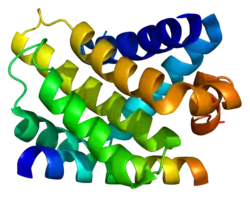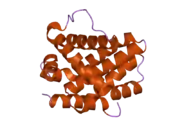MCL1
Induced myeloid leukemia cell differentiation protein Mcl-1 is a protein that in humans is encoded by the MCL1 gene.[5][6]
Function
The protein encoded by this gene belongs to the Bcl-2 family. Alternative splicing occurs at this locus and two transcript variants encoding distinct isoforms have been identified. The longer gene product (isoform 1) enhances cell survival by inhibiting apoptosis while the alternatively spliced shorter gene product (isoform 2) promotes apoptosis and is death-inducing.[7] The protein MCL1 has a very short biological half-life of only 20–30 minutes.[8]
The loss of MCL1 has a more dramatic impact than the loss of any other anti-apoptotic member of the Bcl-2 family. Loss of the Mcl-1 gene results in embryo death when the embryo is only around 3.5 days old, before it has even implanted. Conditional deletion of Mcl-1 depletes a wide variety of cells, including hematopoietic stem cells, B cell–committed progenitors, T cell–committed progenitors, antibody-secreting plasma cells, cardiac muscle cells, and neurons.[8] Deletion of Mcl-1 in hepatocytes causes apoptosis and aberrant polyploidization but improves liver regeneration after surgery.[9][10] MCL1 works synergistically with p53 in protecting liver from injury, fibrosis and cancer.[11]
MCL1 also has a role in the cell's energy production, working in the intermitochondrial space.[8]
Clinical significance
Omacetaxine mepesuccinate (a drug approved for the treatment for chronic myelogenous leukemia) and Seliciclib[12] (which is under investigation as a potential multiple myeloma treatment) both act in part by inhibiting synthesis of Mcl-1. MCL1 has been identified as a resistance factor for BCL-2 inhibitor venetoclax in lymphoma cells. Therefore, new strategies of combining BCL-2 and MCL1 inhibitors are currently under clinical trials for several tumor types.[13]
Interactions
MCL1 has been shown to promiscuously interact with:
References
- GRCh38: Ensembl release 89: ENSG00000143384 - Ensembl, May 2017
- GRCm38: Ensembl release 89: ENSMUSG00000038612 - Ensembl, May 2017
- "Human PubMed Reference:". National Center for Biotechnology Information, U.S. National Library of Medicine.
- "Mouse PubMed Reference:". National Center for Biotechnology Information, U.S. National Library of Medicine.
- Kozopas KM, Yang T, Buchan HL, Zhou P, Craig RW (April 1993). "MCL1, a gene expressed in programmed myeloid cell differentiation, has sequence similarity to BCL2". Proceedings of the National Academy of Sciences of the United States of America. 90 (8): 3516–3520. Bibcode:1993PNAS...90.3516K. doi:10.1073/pnas.90.8.3516. PMC 46331. PMID 7682708.
- Craig RW, Jabs EW, Zhou P, Kozopas KM, Hawkins AL, Rochelle JM, et al. (September 1994). "Human and mouse chromosomal mapping of the myeloid cell leukemia-1 gene: MCL1 maps to human chromosome 1q21, a region that is frequently altered in preneoplastic and neoplastic disease". Genomics. 23 (2): 457–463. doi:10.1006/geno.1994.1523. PMID 7835896.
- "Entrez Gene: MCL1 myeloid cell leukemia sequence 1 (BCL2-related)".
- Kelly GL, Strasser A (March 2020). "Toward Targeting Antiapoptotic MCL-1 for Cancer Therapy". Annual Review of Cancer Biology. 4: 299–313. doi:10.1146/annurev-cancerbio-030419-033510.
- Weng SY, Yang CY, Li CC, Sun TP, Tung SY, Yen JJ, et al. (April 2011). "Synergism between p53 and Mcl-1 in protecting from hepatic injury, fibrosis and cancer". Journal of Hepatology. 54 (4): 685–694. doi:10.1016/j.jhep.2010.07.035. PMID 21146511.
- Hikita H, Takehara T, Shimizu S, Kodama T, Li W, Miyagi T, et al. (October 2009). "Mcl-1 and Bcl-xL cooperatively maintain integrity of hepatocytes in developing and adult murine liver". Hepatology. 50 (4): 1217–1226. doi:10.1002/hep.23126. PMC 3560852. PMID 19676108.
- Weng, Shih-Yen; Yang, Chia-Yu; Li, Chao-Chin; Sun, Te-Ping; Tung, Shu-Yun; Yen, Jeffrey Jong-Young; Tsai, Ting-Fen; Chen, Chun-Ming; Chen, Sung Ho; Hsiao, Michael; Huang, Pei-Hsin (April 2011). "Synergism between p53 and Mcl-1 in protecting from hepatic injury, fibrosis and cancer". Journal of Hepatology. 54 (4): 685–694. doi:10.1016/j.jhep.2010.07.035. PMID 21146511.
- MacCallum DE, Melville J, Frame S, Watt K, Anderson S, Gianella-Borradori A, et al. (June 2005). "Seliciclib (CYC202, R-Roscovitine) induces cell death in multiple myeloma cells by inhibition of RNA polymerase II-dependent transcription and down-regulation of Mcl-1". Cancer Research. 65 (12): 5399–5407. doi:10.1158/0008-5472.CAN-05-0233. PMID 15958589.
- Bolomsky, Arnold; Vogler, Meike; Köse, Murat Cem; Heckman, Caroline A.; Ehx, Grégory; Ludwig, Heinz; Caers, Jo (December 2020). "MCL-1 inhibitors, fast-lane development of a new class of anti-cancer agents". Journal of Hematology & Oncology. 13 (1): 173. doi:10.1186/s13045-020-01007-9. ISSN 1756-8722. PMC 7731749. PMID 33308268.
- Leu JI, Dumont P, Hafey M, Murphy ME, George DL (May 2004). "Mitochondrial p53 activates Bak and causes disruption of a Bak-Mcl1 complex". Nature Cell Biology. 6 (5): 443–450. doi:10.1038/ncb1123. PMID 15077116. S2CID 43063712.
- Willis SN, Chen L, Dewson G, Wei A, Naik E, Fletcher JI, et al. (June 2005). "Proapoptotic Bak is sequestered by Mcl-1 and Bcl-xL, but not Bcl-2, until displaced by BH3-only proteins". Genes & Development. 19 (11): 1294–1305. doi:10.1101/gad.1304105. PMC 1142553. PMID 15901672.
- Weng C, Li Y, Xu D, Shi Y, Tang H (March 2005). "Specific cleavage of Mcl-1 by caspase-3 in tumor necrosis factor-related apoptosis-inducing ligand (TRAIL)-induced apoptosis in Jurkat leukemia T cells". The Journal of Biological Chemistry. 280 (11): 10491–10500. doi:10.1074/jbc.M412819200. PMID 15637055.
- Bae J, Leo CP, Hsu SY, Hsueh AJ (August 2000). "MCL-1S, a splicing variant of the antiapoptotic BCL-2 family member MCL-1, encodes a proapoptotic protein possessing only the BH3 domain". The Journal of Biological Chemistry. 275 (33): 25255–25261. doi:10.1074/jbc.M909826199. PMID 10837489.
- Chen L, Willis SN, Wei A, Smith BJ, Fletcher JI, Hinds MG, et al. (February 2005). "Differential targeting of prosurvival Bcl-2 proteins by their BH3-only ligands allows complementary apoptotic function". Molecular Cell. 17 (3): 393–403. doi:10.1016/j.molcel.2004.12.030. PMID 15694340.
- Hsu SY, Lin P, Hsueh AJ (September 1998). "BOD (Bcl-2-related ovarian death gene) is an ovarian BH3 domain-containing proapoptotic Bcl-2 protein capable of dimerization with diverse antiapoptotic Bcl-2 members". Molecular Endocrinology. 12 (9): 1432–1440. doi:10.1210/mend.12.9.0166. PMID 9731710.
- Heckmeier, Philipp J.; Ruf, Jeannette; Buhrke, David; Janković, Brankica G.; Hamm, Peter (September 2022). "Signal Propagation Within the MCL-1/BIM Protein Complex". Journal of Molecular Biology. 434 (17): 167499. doi:10.1016/j.jmb.2022.167499.
- Bae J, Hsu SY, Leo CP, Zell K, Hsueh AJ (October 2001). "Underphosphorylated BAD interacts with diverse antiapoptotic Bcl-2 family proteins to regulate apoptosis". Apoptosis. 6 (5): 319–330. doi:10.1023/A:1011319901057. PMID 11483855. S2CID 23119757.
- Makishima T, Yoshimi M, Komiyama S, Hara N, Nishimoto T (September 2000). "A subunit of the mammalian oligosaccharyltransferase, DAD1, interacts with Mcl-1, one of the bcl-2 protein family". Journal of Biochemistry. 128 (3): 399–405. doi:10.1093/oxfordjournals.jbchem.a022767. PMID 10965038.
- Heckmeier, Philipp J.; Ruf, Jeannette; Janković, Brankica G.; Hamm, Peter (7 March 2023). "MCL-1 promiscuity and the structural resilience of its binding partners". The Journal of Chemical Physics. 158 (9). doi:10.1063/5.0137239.
- Fujise K, Zhang D, Liu J, Yeh ET (December 2000). "Regulation of apoptosis and cell cycle progression by MCL1. Differential role of proliferating cell nuclear antigen". The Journal of Biological Chemistry. 275 (50): 39458–39465. doi:10.1074/jbc.M006626200. PMID 10978339.
- Czabotar, Peter E.; Lee, Erinna F.; van Delft, Mark F.; Day, Catherine L.; Smith, Brian J.; Huang, David C. S.; Fairlie, W. Douglas; Hinds, Mark G.; Colman, Peter M. (10 April 2007). "Structural insights into the degradation of Mcl-1 induced by BH3 domains". Proceedings of the National Academy of Sciences. 104 (15): 6217–6222. doi:10.1073/pnas.0701297104.
- Liu H, Peng HW, Cheng YS, Yuan HS, Yang-Yen HF (April 2005). "Stabilization and enhancement of the antiapoptotic activity of mcl-1 by TCTP". Molecular and Cellular Biology. 25 (8): 3117–3126. doi:10.1128/MCB.25.8.3117-3126.2005. PMC 1069602. PMID 15798198.
- Bae J, Donigian JR, Hsueh AJ (February 2003). "Tankyrase 1 interacts with Mcl-1 proteins and inhibits their regulation of apoptosis". The Journal of Biological Chemistry. 278 (7): 5195–5204. doi:10.1074/jbc.M201988200. PMID 12475993.
Further reading
- Yang-Yen HF (March 2006). "Mcl-1: a highly regulated cell death and survival controller". Journal of Biomedical Science. 13 (2): 201–204. doi:10.1007/s11373-005-9064-4. PMID 16456709.









